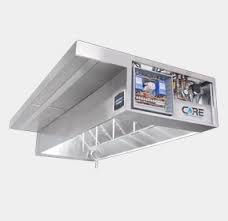Designing a restaurant exhaust system is a critical endeavor that requires careful consideration of both functional and regulatory aspects. An efficient and well-designed exhaust system not only ensures a comfortable dining environment but also plays a pivotal role in maintaining air quality, complying with safety regulations, and optimizing kitchen operations. In this comprehensive exploration, we delve into the key factors, principles, and best practices that guide the creation of an effective restaurant exhaust system.
1. Understanding the Importance of Restaurant Exhaust Systems
A restaurant's kitchen is a symphony of sizzling pans, aromatic ingredients, and culinary creativity. Amidst this orchestration, the exhaust system stands as a silent conductor, directing smoke, heat, grease, and odors away from the cooking area. By effectively removing these byproducts, the exhaust system contributes to a comfortable dining environment, minimizes fire hazards, and ensures compliance with health and safety regulations.
2. Assessing Kitchen Layout and Size
The foundation of an effective exhaust system lies in a thorough assessment of the kitchen's layout and size. Different culinary establishments have varying demands, whether it's a cozy bistro, a bustling café, or a fine dining restaurant. The exhaust system's design should align with the kitchen's workflow, equipment placement, and the type of cuisine being prepared. Adequate hood coverage and optimal placement are essential to capture and remove airborne contaminants effectively.
3. Airflow and Ventilation Principles
Central to the design of a restaurant exhaust system is the understanding of airflow and ventilation principles. Airflow patterns are influenced by factors such as the placement of cooking equipment, the size of the kitchen, and the type of exhaust hood. Creating a balanced airflow ensures that contaminants are efficiently captured and transported through the ductwork to the exterior.
4. Type of Exhaust Hoods
Selecting the appropriate type of exhaust hood is a critical decision that impacts the system's performance. Common types include canopy hoods, proximity hoods, and island hoods. The choice depends on the kitchen's layout, the equipment being used, and the cooking methods employed. An exhaust hood should be sized adequately to cover the cooking area and capture the generated contaminants.
5. Ductwork Design and Sizing
Ductwork serves as the conduit through which contaminants are transported from the exhaust hood to the exterior. Proper ductwork design and sizing are essential to maintain efficient airflow and prevent the accumulation of grease and residue. Ductwork materials, insulation, and routing should adhere to safety regulations and local codes.
6. Filtration and Grease Removal
A robust filtration system is integral to the effectiveness of a restaurant hood systems. Grease and smoke particles must be captured before they enter the ductwork to prevent buildup and potential fire hazards. Baffle filters, mesh filters, and high-efficiency particulate air (HEPA) filters are commonly used to ensure efficient grease removal.
7. Fire Suppression and Safety Measures
Safety is paramount in any kitchen environment. Integrating fire suppression systems with the exhaust system adds an extra layer of protection. Automatic fire suppression systems can detect and extinguish fires that may occur within the exhaust system, minimizing the risk of kitchen fires spreading.
8. Noise Control and Acoustics
Efficient exhaust systems can sometimes generate noise that disrupts the dining experience. Employing noise control measures, such as acoustic insulation and vibration dampening, helps maintain a peaceful ambiance in the dining area while ensuring effective kitchen operations.
9. Compliance with Regulations
Designing a restaurant exhaust system requires meticulous adherence to local, state, and national regulations. Health and safety codes, fire codes, and environmental standards must be considered to ensure that the exhaust system meets all legal requirements.
10. Regular Maintenance and Inspection
A well-designed exhaust system is only effective if it is properly maintained. Regular cleaning, inspection, and maintenance of exhaust hoods, filters, and ductwork are essential to prevent the buildup of grease and ensure optimal performance.
Conclusion
Designing an effective restaurant exhaust system requires a delicate balance of technical expertise, practical considerations, and compliance with regulations. By understanding the unique needs of the culinary establishment, considering airflow dynamics, and incorporating safety measures, a well-designed exhaust system contributes to a comfortable dining experience, a safe kitchen environment, and compliance with health and safety standards. As the culinary world continues to evolve, a thoughtfully designed exhaust system stands as an essential element that enhances both the culinary journey and the well-being of patrons, chefs, and staff alike.


No comments yet